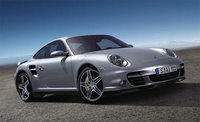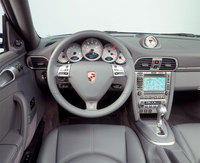The New Porsche 911 Turbo--the Most Potent and Capable Yet--Arrives at Dealerships This Week
ATLANTA--June 21, 2006--
| The Sports Car that Some Consider the Benchmark for Everyday Supercars Features a Twin turbocharger, variable turbine geometry (VTG) and electronically controlled all-wheel-drive |
Porsche is set to unleash the newest and flat-out fastest version of what many consider the world's best performing and most technologically advanced sports cars in the world beginning this week at Porsche dealerships across North America. The 2007 911 Turbo goes on sale June 24, 2006 in North America. The official on-sale date is June 24 in the U.S. and in Canada.
The ground-breaking 2007 911 Turbo--the sixth generation of what is the ultimate version of the venerable 911 model--provides towering performance in a practical, stylish and functional package suitable for everyday use. Unlike other sports car exotics that end up spending most days stored for special drive time, the 911 Turbo's virtuoso performance is ready for commuting through a workday or letting go on a race track.
For the first time, the 911 Turbo is able to reach 60 mph from a standing start in less than four seconds thanks in part to the new Turbo's power that comes from a revolutionary, 480-horsepower, twin-turbocharged, 3.6-liter boxer engine featuring Porsche's first application of variable turbine geometry (VTG). The new 911 Turbo also offers a redesigned, electronically controlled all-wheel-drive system, and evolutionary styling.
When re-fashioning a classic look, Porsche designers made certain that the core and intrinsic beauty of the 911 Turbo remained. The 2007 911 Turbo, which represents the top of the 911 model range, has an exterior design which is more outwardly expressive than that of the former model but true to its famous pedigree. Strikingly chiseled intake air scoops, with integrated LED directional indicators, and foglamps moved far to the outside give the front end a unique, characteristic look. The rear end, in turn, now exudes an even more distinctive impression of power thanks to the wheel arches widened by 22mm (0.87"), and tailpipes raised and integrated into the rear clip. The side air intakes behind the doors have also been redesigned, contributing to the special look of the 911 Turbo. Even with this new design, the new Turbo weighs less than its predecessor.
Boasting its new tailor-made suit, the 2007 911 Turbo offers excellent aerodynamics. Despite the wider body, the greater intake of cooling air, and 19-inch wheels, the drag coefficient remains unchanged at a Cd of just 0.31. At the same time Porsche engineers reduced lift on the front axle, and once again increased downforce at the rear, partially the result of extending the newly contoured split wing. Even at top speed, the driver enjoys superior stability, and clear-cut, easily calculable reactions.
The new 2007 911 Turbo joins the 911 models series--launched in the latter half of 2005--during its best sales in the U.S. in history with sales for the first five months of the run running nearly 20 percent ahead of last year. Overall, the Porsche brand has broken monthly sales records in four of the last five months, led in large part by the success of the 911, a car whose classic shape and performance on the streets and on race track during the past 40 years plus years has helped symbolize the legendary Porsche brand. Already the world's most popular German luxury sports car model series ever, the 911 promises to build even more sales momentum with the addition of this ground-breaking new addition to the series.
Porsche first turbo, a racing car called the 917/10, raised the bar in automotive performance beginning in 1972 when it dominated championships. A year later a production car was created, the 911 Turbo, achieving unprecedented power and pull for an engine of its size at that time.
Today that initial innovation in turbo technology continues with the new 911. Offering a truly cutting-edge package of new and innovative technology features, the 2007 Porsche 911 Turbo sets an unprecedented benchmark in driving dynamics. The key elements of this package are the two turbochargers which for the first time feature variable turbine geometry (VTG), as well as Porsche's newly developed and fully controlled all-wheel-drive: Porsche Traction Management (PTM).
Interacting efficiently with one another, these two systems offer the driver an even wider performance envelope. Accelerating all-out with the standard six-speed manual gearshift, the new 911 Turbo reaches the 160 km/h-mark (99 mph) in just 8.4 seconds. Combining the new turbocharger technology and Porsche Traction Management with the newly optimized Tiptronic S transmission allows the 2007 911 Turbo to reach this same mark in only 7.8 seconds. With either transmission, top test-track speed is 193 mph (310 km/h).
For the first time, the power unit of the new Porsche 911 Turbo features an exhaust gas turbocharger with variable turbine geometry (VTG). VTG provides for efficient control of the exhaust gas flow throughout the entire range of engine speed, guiding the flow of air in exactly the right direction and at the right angle to the turbine blades. The result is yet another increase in engine output, despite engine capacity remaining unchanged at 3.6 liters, up from 420 horsepower to 480 horsepower. Maximum torque, in turn, is up from 415 lb.-ft. to 460 lb.-ft., and meaningful twist is on tap beginning at a low 1950 rpm.
Essentially, with advancements such as VTG, the new Turbo not only pushes the envelope as drivers have expected from the Porsche brand, it really shreds that envelope with the previously mentioned first actively controlled all wheel drive that puts all the power on the road and aids in active safety; an advanced six-speed manual transmission and even quicker 5-speed Tiptronic(R) S; a optional Sports Chrono Package Turbo for overboost power--an advantage in short, interim acceleration and overtaking maneuvers: Porsche Active Suspension Management (PASM) for a sporty to more comfortable set-up while driving; An upgraded braking system derived from the Carrera GT supercar as well as Porsche's ultimate stopping system with the Porsche Ceramic Composite Brakes (PCCB)(R) for truly outstanding braking qualities ensured by ceramic brake discs, and further developed in even larger dimensions than before.
One of the most innovative new Porsche features is the unique Fast-Off feature that prevents the Tiptronic S transmission from upshifting, even if the driver does not release the gas pedal completely. This improves driving dynamics, particularly on winding or serpentine roads. The new Fast-Back function enables the driver to downshift more quickly when applying the brakes in a sporting style, when moving over quickly from the accelerator to the brake pedal. When braking into a bend, for example, Fast-Back automatically helps select the proper gear for subsequently accelerating out of the bend.
This and the multitude of other active safety features are joined by Porsche's renowned standard safety features on the new Turbo that include: full-size airbags for the driver and front passenger, with an entire range of six airbags including two head airbags in the side window sills interacting in a side-on collision with thorax airbags in the front seat backrests. The six airbags mentioned consist of two full-size two-stage frontal airbags and the trendsetting Porsche Side Impact Protection (POSIP) system.
Over and above door reinforcements, the POSIP system is made up of a thorax airbag on the outside of each seat backrest and a head airbag in each door. Porsche was the first car maker in the world to feature this technology. In a collision from the side, the head airbag inflates from bottom to top to form a flat cushion with a total capacity of 8 liters, helping prevent the occupant's head from impacting the side window.
Other significant advancements for the new 911 Turbo include: a underfloor of that is enclosed almost completely to ensure consistent airflow conditions, reducing turbulence and air swirl to a minimum; and to meet the greater cooling requirements of the more powerful engine and to ensure an ample flow of cooling air, the entire air flow system has been modified by adding a special bypass. Additionally, nineteen-inch forged wheels, developed exclusively for the 2007 911 Turbo in a two-tone, tri-spoke design, add a particularly stylish touch to the car. Apart from lower weight, forging technology helps reduce the cross-section of the spokes to a minimum, providing a clear, unobstructed view of the brake calipers.
Complete information on all Porsche models can be found at www.press.porsche.com in the Press Kit section.
Porsche Cars North America, Inc. (PCNA), based in Atlanta, GA, and its subsidiary, Porsche Cars Canada, Ltd., are the exclusive importers of Porsche sports cars and Cayenne(R) sport utility vehicles for the United States and Canada. A wholly owned, indirect subsidiary of Dr. Ing. h.c. F. Porsche AG, PCNA employs approximately 300 people who provide Porsche vehicles, parts, service, marketing and training for its 214 U.S. and Canadian dealers. They, in turn, provide Porsche owners with best-in-class service.




